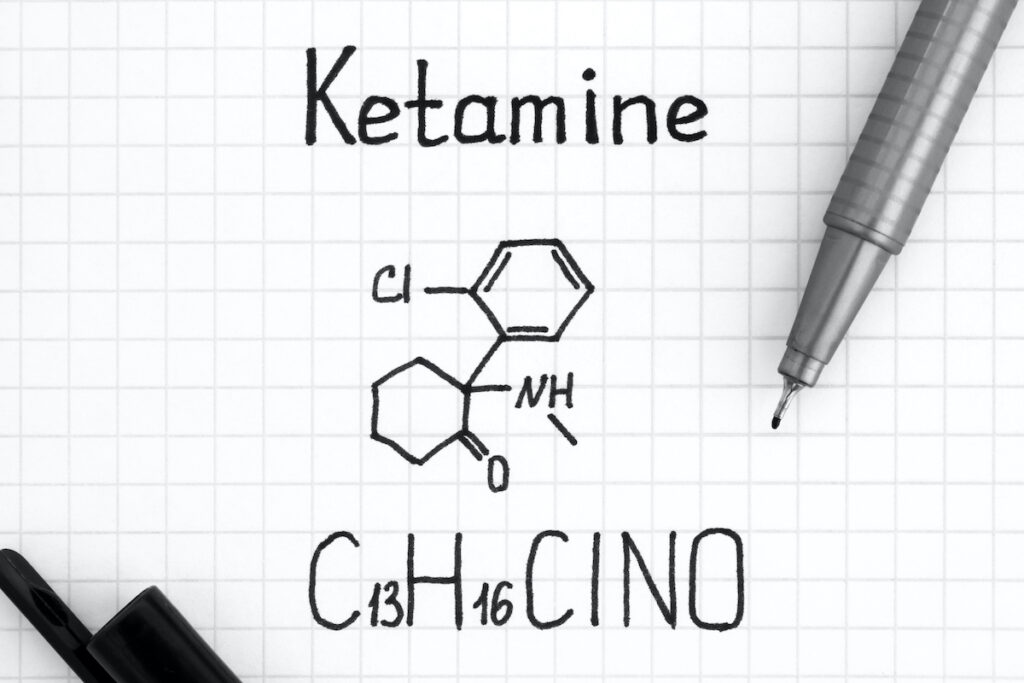
Ketamine has shown benefit as a rapid treatment for symptoms of depression (Kryst et al., 2020). However, ketamine has downsides: the potential to lead to addiction (Bonaventura et al., 2021), dissociative side effects and long term high dose use may be associated with neurotoxicity and bladder problems (Zhu, et al., 2016).
Everyone wants to know how ketamine works, with one intention of developing new treatments. One such avenue is looking at ketamine’s metabolites. 2R,6R-hydronorketamine (2R-6R-HNK) has got a lot of people excited. It shows antidepressant-like effects in animals and seems to lack the adverse effects and abuse potential.
Another focus of research is the search for biomarkers. Gamma power (also known as gamma waves, gamma oscillations) has been touted as a potential biomarker in major depressive disorder (Fitzgerald and Watson, 2018). Gamma power is a brain activity that can be measured by EEG or MEG – easy enough to do in humans. Previous research has shown that ketamine infusions increase gamma power and that depressed patients who have low baseline gamma power have a better clinical response to ketamine than those with higher baseline gamma power.
Furthermore, animal research has shown that (2R,6R)-HNK increases gamma power.
It has been hypothesised that this all links to synaptic plasticity, which is purported to be a mechanism for ketamine’s antidepressant effect. Thus, (2R,6R)-HNK may promote synaptic plasticity and gamma power may be a biomarker of this.
The authors conducted an exploratory analysis to assess the relationship between ketamine’s metabolites and antidepressant, dissociative effects and their effects on gamma power. They hypothesised that:
- Increased ketamine and norketamine plasma concentrations would be related to improved acute response (at 230 mins);
- Increased (2S,6S;2R,6R)-HNK would be related to improved extended response (at Day 7);
- (2S,6S;2R,6R)-HNK concentrations will positively correlate with greater increases in resting-state gamma power 6-9 hours post-infusion;
- Concentrations of ketamine and NK would positively correlate to dissociative side effects at 40 mins post-infusion, with no association with HNK metabolites.

Ketamine’s metabolites may have their own antidepressant effect, without the negative side effects. It may be possible to measure gamma power with electrophysiological tools to use as a biomarker of this antidepressant effect.
Methods
This paper describes the results for 34 patients with treatment-resistant depression and 23 healthy controls. Data for healthy controls were used for the dissociation analyses only.
All patients were free from psychotropic medication before entering the study.
The study was a crossover design, meaning all participants received both the placebo and ketamine. Patients received a 40-minute infusion of 0.5mg/kg ketamine or saline 2 weeks apart, in an inpatient setting.
Measurements of depression symptoms (using the MADRS) and dissociation (using the CADSS) were blinded and conducted frequently on the day of infusion and up to 11 days post-infusion.
The study also collected plasma samples at several instances on the day of infusion and until day 3 post-infusion. They measured ketamine, norketamine (NK) and hydroxynorketamine (HNK) concentrations.
Gamma power was recorded using MEG (magnetoencephalography) during resting-state (i.e. whilst participants were quietly resting), 6-9 hours after ketamine infusion.
Results
There were 31 patients with unipolar depression and 3 with bipolar depression, while of those 65% were female. Their mean age was 36.12 years old. The mean MADRS score at baseline was 33.65, corresponding to moderate depression.
Hypothesis 1
- Ketamine concentrations did not mediate antidepressant response at acute time points
- However, ketamine concentrations did predict better extended antidepressant response at day 11.
Hypothesis 2
- In fact, lower (2S,6S;2R,6R)-HNK concentrations were associated with a better antidepressant response at days 3 and 7, but not day 11.
Hypothesis 3
- Higher (2S,6S;2R,6R)-HNK concentrations were related to higher gamma power in most of the brain
- Though not hypothesised, the authors noted that NK concentrations were negatively associated with gamma power
- There were no associations between ketamine concentrations and gamma power.
Hypothesis 4
- Ketamine, NK and (2S,6S;2R,6R)-HNK metabolites all correlated with higher CADSS scores, however in a predictive model, only ketamine concentration predicted higher CADSS total scores.
- This study also found that there was no relationship between (2S,6S;2R,6R)-HNK concentrations, gamma power and antidepressant response.

Contrary to predictions, higher ketamine concentrations predicted better antidepressant response at Day 11, whereas higher concentrations of the pre-clinically promising metabolite (2S,6S;2R,6R)-HNK predicted worse response.
Conclusions
This study did not identify any new relationships between ketamine metabolites and antidepressant effects, that would support the development of a new ketamine-like treatment.
(2S,6S;2R,6R)-HNK concentrations correlated with greater increases in resting-state gamma power. This suggests that (2S,6S;2R,6R)-HNK is associated with increased cortical excitation, which may mean it is important for ketamine’s antidepressant effect.
Only ketamine concentrations predicted greater dissociation. This supports prior findings that ketamine functionally inhibits NMDA-receptors and that this inhibition mediates the dissociative effects.

This study did not identify any new relationships between ketamine metabolites and antidepressant effects that would support the development of a new ketamine-like treatment.
Strengths and limitations
A key strength is that this paper replicates the findings of an earlier study, showing that higher (2S,6S;2R,6R)-HNK concentrations link to less symptomatic improvement. The richness of the pharmacokinetic data is important for guiding future research. It is useful that the authors relied on confidence intervals and effect sizes, rather than p-values, which will aid future meta-analytic work.
As with all ketamine research, it is important to be aware that though this was placebo-controlled study, ketamine has strong psychoactive effects which can break the blind. Antidepressant effect sizes of ketamine have been shown to be lower where an active placebo is used (Wilkinson et al., 2019). Thus, correlations of drug plasma levels, MEG and antidepressant response will benefit from replication with an active placebo.
A limitation of the measurements used is that although the CADSS is widely used for measuring ketamine-induced dissociation, it was developed for measuring dissociation in PTSD, and does not necessarily fully capture ketamine’s dissociative effects.
As the authors acknowledge, an important limitation is that metabolites were measured in the plasma, which may not reflect what is happening in the nervous system. Moreover, the sample size is relatively small and we must remember this is an exploratory analysis. The relationship between ketamine metabolites and the antidepressant response may also be non-linear, which a smaller study like this possibly would not be able to pick up (Abdallah, 2020).
Finally, an important limitation is the financial conflict of interest of three of the authors, including the senior author. They are co-inventors on patents or patent applications for ketamine and its metabolites in the treatment of depression and other psychiatric disorders, and would share a percentage of any earnings that may result from the sales of future treatments.
The authors weave together a complex set of findings and concepts into an interesting, though complicated, story that extends our search for ketamine’s mechanism of action.

This study contributes to our search for understanding the mechanism of ketamine’s antidepressant effect, albeit in a relatively small sample.
Implications for practice
This study replicates the finding of a negative relationship between (2S,6S;2R,6R)-HNK levels and mood improvement. This metabolite had generated some excitement on the basis of preclinical research in animals, so testing the facts in humans sooner rather than later is crucial. (2S,6S;2R,6R)-HNK has generated so much interest in part due to its lack of dissociative side effects, again demonstrated in this study. However, a question has been raised as to whether the dissociative effects are in fact a necessary part of ketamine’s antidepressant effects (Ballard et al, 2020, Grabski et al, 2020).
This study also contributes to the search for biomarkers in depression, showing a link between ketamine’s metabolites and gamma power measured by MEG. Though this paper alone won’t change practice, it is a growing field and the authors add another piece to the puzzle.
Overall, this study underlines the importance of conducting studies of drug mechanisms in humans, as conclusions from these may not match up to what has been found in animals.

The authors demonstrate a link between ketamine’s metabolites and gamma power, which adds to the growing research on gamma power as a potential biomarker in depression.
Statement of interests
Anya has worked on a clinical trial of ketamine for alcohol use disorder, but was not involved in this study.
Links
Primary paper
Farmer, C. A., Gilbert, J. R., Moaddel, R., George, J., Adeojo, L., Lovett, J., Nugent, A. C., Kadriu, B., Yuan, P., Gould, T. D., Park, L. T., & Zarate, C. A., Jr (2020). Ketamine metabolites, clinical response, and gamma power in a randomized, placebo-controlled, crossover trial for treatment-resistant major depression. Neuropsychopharmacology: official publication of the American College of Neuropsychopharmacology, 45(8), 1398–1404. [PubMed abstract]
Other references
Abdallah, C.G. (2R,6R)-Hydroxynorketamine (HNK) plasma level predicts poor antidepressant response: is this the end of the HNK pipeline?. Neuropsychopharmacol. 45, 1245–1246 (2020).
Ballard, E. D., & Zarate, C. A., Jr (2020). The role of dissociation in ketamine’s antidepressant effects. Nature communications, 11(1), 6431.
Bonaventura, J., Lam, S., Carlton, M., Boehm, M. A., Gomez, J. L., Solís, O., Sánchez-Soto, M., Morris, P. J., Fredriksson, I., Thomas, C. J., Sibley, D. R., Shaham, Y., Zarate, C. A., Jr, & Michaelides, M. (2021). Pharmacological and behavioral divergence of ketamine enantiomers: implications for abuse liability. Molecular psychiatry. Advance online publication. [PubMed abstract]
Fitzgerald, P. J., & Watson, B. O. (2018). Gamma oscillations as a biomarker for major depression: an emerging topic. Translational psychiatry, 8(1), 177.
Grabski, M., Borissova, A., Marsh, B., Morgan, C., & Curran, H. V. (2020). Ketamine as a mental health treatment: Are acute psychoactive effects associated with outcomes? A systematic review. Behavioural brain research, 392, 112629. [PubMed abstract]
Kryst, J., Kawalec, P., Mitoraj, A. M., Pilc, A., Lasoń, W., & Brzostek, T. (2020). Efficacy of single and repeated administration of ketamine in unipolar and bipolar depression: a meta-analysis of randomized clinical trials. Pharmacological reports : PR, 72(3), 543–562.
Wilkinson, S. T., Farmer, C., Ballard, E. D., Mathew, S. J., Grunebaum, M. F., Murrough, J. W., Sos, P., Wang, G., Gueorguieva, R., & Zarate, C. A., Jr (2019). Impact of midazolam vs. saline on effect size estimates in controlled trials of ketamine as a rapid-acting antidepressant. Neuropsychopharmacology : official publication of the American College of Neuropsychopharmacology, 44(7), 1233–1238.
Zhu, W., Ding, Z., Zhang, Y., Shi, J., Hashimoto, K., & Lu, L. (2016). Risks Associated with Misuse of Ketamine as a Rapid-Acting Antidepressant. Neuroscience bulletin, 32(6), 557–564.
Photo credits
- Photo by Girl with red hat on Unsplash
- Photo by Andrey Novik on Unsplash
